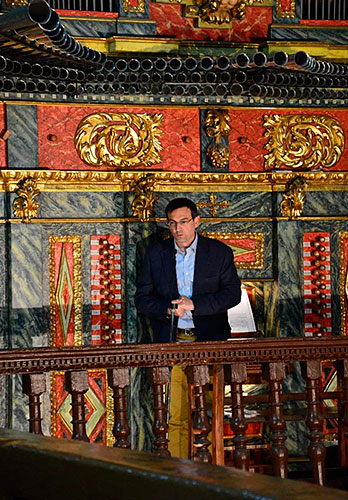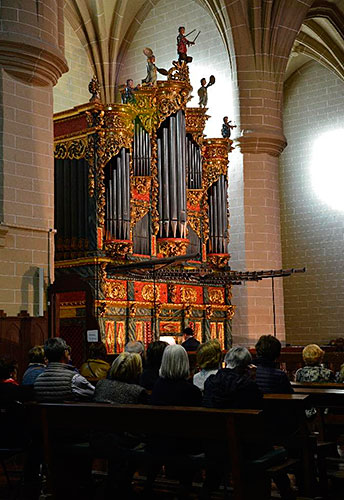8 May
Global Seminars & Invited Speaker Series
THE WORK IN ITS CONTEXT
The organ of Santo Domingo
Raúl del Toro Sola
Pablo Sarasate" Conservatory of Pamplona
The organ in the church of Santo Domingo in Pamplona has the characteristics of the 18th century Spanish organ school. It has two manual keyboards(Major Organ and Cadereta) and a series of 8 Contras stops, corresponding to the seven natural notes of the scale plus the B flat.

The stops of the Great Organ are divided in such a way that the stops on the left side affect the left or bass half of the keyboard, and those on the right side affect the right or treble half. In the Spanish tradition the point of division is between the central C natural (C3) and the adjacent C sharp (C#3), and this is also where this main keyboard of the organ of Santo Domingo is divided.
Three families of registers are represented on this Major Organ keyboard: the principals or flutes, the nasardos or flutes, and the reeds.
Organ pipes can be divided into two main groups: labial or hollow pipes, in which the sound is produced by the passing air, and reed pipes, in which the sound is produced by a small blade or reed.
The labial tubes are further divided into three families according to the greater or lesser width of their tubes. The widest pipes characterise the nasard or flute family; the narrowest pipes form the shrimp family, and those of intermediate diameter constitute the principal family. This is the characteristic stop family of the organ, the most important and the only one that historically existed in small organs, which had few stops.
The organ of Santo Domingo, like the vast majority of European baroque organs, lacks gambas. The other two families of lip stops, the principal and the nasardos, are well represented.
Both the principal and the nasard family have different pitches for each key. The tubes of each register are of different lengths: those with longer tubes produce lower sounds, and those with smaller tubes produce higher sounds. As a result, lowering a single key actually produces different notes, more or less depending on the issue of these registers that have been taken out. The difference in pitch between these sounds is not arbitrary, but corresponds exactly to the proportions of the acoustic waves they produce: one half, one third, one quarter, one fifth, etc. The resulting intervals are octaves, fifths and thirds at various pitches. It is not by chance that these intervals constitute the basic material of harmony and polyphony.
By activating this whole "pyramid" of sounds (from bass to treble), a new timbre is created, in a similar way to modern synthesizers. These timbres or combinations of registers are called Full in the principal family, and Cornet in the nasard family.

In the reed family we distinguish in the organ of Santo Domingo between the Royal Trumpet, whose pipes are in a vertical position inside the case, and the various stops of the Battle Trumpet, which are arranged horizontally on the front of the case. This is another characteristic of the Spanish Baroque organ. In this organ the battle reeds can be activated or deactivated by the organist without the need to take his hands away from the keyboard, thanks to two knee pads, one for each half of the keyboard, which the organist moves laterally with his knees, as the name of the device indicates.
The secondary keyboard or Cadereta has its pipes inside the box on the lower floor. Among its registers, the transverse flute deserves a accredited specialization , in which in each grade two pipes sound in unison, slightly out of tune, so that the collision of both sound waves almost equal but not the same produces a slight vibration or oscillation in the sound, reminiscent of the timbre of the real transverse flute.
Another interesting device is the echo chest. This is a box or ark, as the name suggests, inside which the pipes of one or more registers are hidden. This box has a lifting lid, which is opened and closed by the organist's foot thanks to a pulley system. It was the way in which baroque organ builders tried to imitate the expressive effects of crescendo and diminuendo, so beautiful on the human voice and various instruments, but impracticable for technical reasons on keyboard instruments such as the organ or the core topic.
This organ in Santo Domingo contains a veritable showcase of the colourful sound effects with which organ builders liked to decorate their instruments. Each of these effects is activated by means of a treadle that the organist has under the keyboards and within easy reach of his feet.
Thus, various combinations of bass pipes singing at a distance of half a tone, depending on whether they sing higher or lower, produce the effect of drum, timpani or thunder.
Behind the organ case there is a group of small pipes placed in a semicircle on a container. By pouring water into it up to the height of the pipes, the sound effect imitates birdsong quite closely.
It is also possible to imitate the drone of the Celtic bagpipes by means of two pipes that sing in a fixed interval of a fifth. Finally, the revolanderas are bells placed on a wheel which is made to rotate by means of a current of air which the organist makes pass through by means of the corresponding device.
